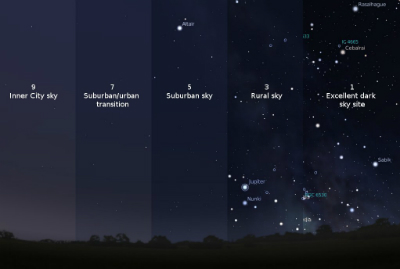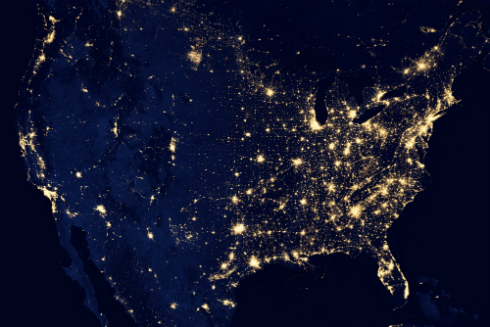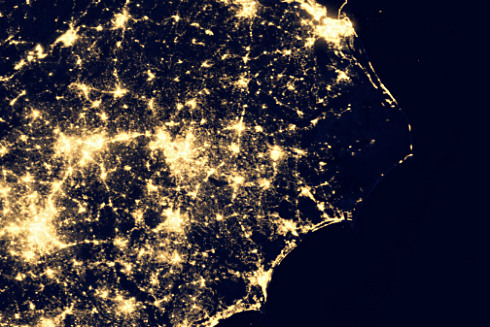 From left to right, the visibility of stars at night from the inner city to the undeveloped areas. Cape Hatteras National Seashore’s “Starry, Starry Night” initiative seeks to diminish light pollution and preserve the night sky as a natural resource. If it becomes an International Dark-Sky Park, it will be the first park along a coast to do so. Graphic: Stellarium |
HATTERAS — A truly dark sky is an awe-inspiring natural resource that is being lost, and a spare few notice.
Many people rarely, if ever, have enjoyed the full spectacle that is the night sky, and only then do they know what they’ve missed. Floodlights, streetlights, headlights, door lights, pool lights, security lights, porch lights — all conspire to dim the dazzle of the nightscape.
Supporter Spotlight
Sunrise, sunset and rainbows may be the sky-candy that never fails to delight, but it is the stars and moon glowing, glittering in vast blackness that enchants and humbles.
Cape Hatteras National Seashore is taking steps to preserve the night, for both people and animals, with its initiative called “Starry, Starry Night,” borrowed from the famous song by Don McLean.
“The Outer Banks, particularly the southern Outer Banks, has one of the darkest skies east of the Mississippi River,” says park spokeswoman Cyndy Holda.
As part of its plan to celebrate the centennial of the National Park Service in 2016, the Cape Hatteras National Seashore is working to qualify as an International Dark-Sky Park, which would make it the second one in the Southeast. The first, Maryland Community College Blue Ridge Observatory and Star Park in North Carolina’s Blue Ridge Mountains, was named in February.
“I’m glad to hear that people are working on coastal protection because that, in a way, is the last frontier,” says John Barentine, program manager with Arizona-based International Dark-Sky Association, a nonprofit founded in 1988 to raise awareness of light pollution.
Supporter Spotlight
The association, which Barentine says was the first of its kind, established the International Dark-Sky Places conservation program in 2001 “to recognize excellent stewardship of the night sky.” Of the organization’s 36 designated dark-sky places in the U.S, southwest Africa and Europe, 20 of them are parks, he said. If Cape Hatteras is added, it would be unique.
“Of all of them in the world,” Barentine says, “none of them are on the coast.”
A view from space of Earth at night, taken by NASA in 2012 in a stunning satellite image, shows nearly all of the eastern half of the U.S. and the East Coast doused in varying intensities of light. In some places, the light is so bright it looks like a floodlight piercing space. But, a close look at the image reveals a skinny dark patch off the N.C. coast –- the location of Cape Hatteras National Seashore.
 This image of the continental U.S. at night is a composite of data from one of NASA’s satellites from April and Oct. 2012. The southern Outer Banks boasts one of the darkest night skies east of the Mississippi. Image: NASA Earth Observatory/NOAA NGDC |
 This is that satellite image zoomed into North Carolina. The dark area that juts out into the Atlantic is the location of Cape Hatteras National Seashore. Image: NASA Earth Observatory/NOAA NGDC |
According to the association’s website, light pollution has negative effects on astronomy, ecosystems and human circadian rhythms. It also wastes $2.2 billion in energy per year in the U.S. alone.
As an example of the power of star-obscuring “sky glow,” Barentine says he was able to see Phoenix’s city lights from 250 miles away while visiting the Grand Canyon.
In Cape Hatteras, night illumination threatens the survival of sea turtles, which are attracted to light and, therefore, lured away from the ocean.
Holda says that an inventory of light sources in the park was taken in 2008 to use in off-road vehicle driving planning, which led to limits on night driving to protect the turtles. In the process of examining light pollution in Cape Hatteras, the park realized what a natural asset it had in its darkness.
Stretching 70 miles along a string of islands, from South Nags Head to Ocracoke, the 30,000-acre park surrounds eight small villages, which are inundated with tourists every summer; but, thanks to the park service, the islands remain largely undeveloped.
Still, the lighting at visitor and staff facilities needs to meet certain criteria to qualify as a dark-sky park. A complete inventory and updated assessment is expected to be completed by year’s end, Holda says. That will help determine what lighting should be modified, updated or removed.
A Dark-Sky Park is defined by the association as “possessing exceptional starry skies,” where light pollution is mitigated and natural darkness is valued as an important resource.
To meet the dark-sky guidelines, 67 percent of all outdoor lighting must comply at application with the park’s “lightscape” management plan — a requirement Holda says the park can likely meet. Then there must be a five-year plan that details when 90 percent of the outdoor lighting will be in compliance. In general, necessary lighting should point down, illuminating only the area that needs to be lit and not scatter where it is not needed.
Preservation of the night sky above national parks is a high priority to the National Park Service, according to itswebsite. Stargazing programs are one of the favorite activities offered to visitors in western parks.
Holda says if Cape Hatteras makes the cut, it would be the first National Seashore to earn the International Dark-Sky Park honor. Not only would the designation enhance sea turtle protection measures, she says, it would also be compatible with the park service’s “Go Green” initiative to reduce its carbon footprint for economic and environmental benefits.
 A sea turtle hatchling becomes disoriented by hotel lights after boiling out of the nest, which depletes its energy and reduces its chance of survival. Necessary lighting should point down, illuminating only the area that needs to be lit and not scatter where it is not needed. Photo: Sea Turtle Camp |
Cape Hatteras National Seashore is already engaged in several programs that feature the night sky, she adds. One of the most popular are the full moonclimbs at the Cape Hatteras Lighthouse and Bodie Island Lighthouse. Others focus on nighttime navigation by the stars and biological activity at night on the beach, such as ghost crabs and photoplankton.
Last year, the park service partnered with Midgett Realty to put stickers beside east-facing light switches in rental cottages to remind visitors to turn out the lights to help the turtles.
Beth Midgett, the company’s reservations manager, says that visitors were very interested and cooperative. Nearly 90 percent of the professionally-managed vacation properties on the island participated in the program, she says.
Midgett says that she hopes to expand the program next year to include outdoor light switches. In the future, it may be possible to work with the community to decrease the lighting overall.
“Of course, there’s a safety factor,” Midgett says. “There’s a lot of stairs on the back sides of these houses, and these are unfamiliar surroundings. But we are more than happy to do whatever we can.”
Beyond turtle safety, light pollution is becoming more of an issue to people on the island.
Bertie Dixon III, a resident of Frisco on Hatteras Island, remembers when his father showed him where the Big and Little Dipper were in the sky and the clarity of the Milky Way in the heavens not so long ago.
“I was amazed to see Sputnik while lying on a blanket near (Cape Point) in 1957,” he says in a comment published last month in the Island Free Press, which covers news of Hatteras and Ocracoke islands.
“Now I have people across the street with an all-night gas light on,” Dixon wrote. “To the left, a spotlight and, besides me, one who comes down and forgets to turn out the outside lights when they leave for weeks.”
The dark-sky association doesn’t want to be the “light cops,” Barentine says. It just wants to encourage people to use only the lighting they need, when they need it. Light should be directed where it is needed for safety and recreation and not spilling into the sky and the neighbor’s windows — or onto the beach.
Barentine says that just switching to LED lighting can save enormous energy costs, but warns that the lighting should be in the warm spectrum. Too much blue spectrum in lighting, he says, creates harsh brightness and unnatural and unhealthy light for people and animals.
The Outer Banks, in general, would have a lot to gain from dimming the lights. If a community is interested, Barentine says, the association can help them create a light ordinance, similar to a noise ordinance, to protect its night palette.
Think of dark skies as “astro-tourism,” that is, a kind of eco-tourism, Barentine says. Not only can appreciation of dark skies be compatible with safety, it can be compatible with growth of tourism, especially when so many areas have been robbed of the beauty of night.
“There is a measurable economic benefit,” he says. “It would be really wonderful for people who live on the East Coast to know that within a few hours drive, they can have a really authentic dark-sky experience.”







